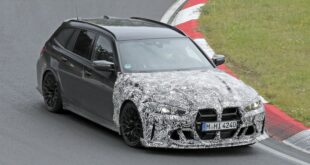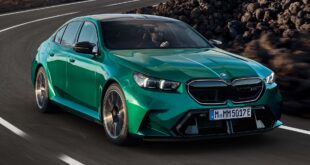Urban all-rounder delivers boundless driving pleasure.

Singapore. BMW Group Asia and Performance Motors Ltd have unveiled the all-new BMW X1, which will be retailing as the BMW X1 sDrive20i.
“The all-new BMW X1 is the successor to the model that blazed the trail for this class of car. The second generation of this successful model, with more than 730,000 units sold worldwide, takes to the stage with a body design straight out of the BMW X model mould. The interior of the all-new BMW X1, meanwhile, offers significantly more space for passengers and luggage, a cutting-edge premium ambience and functionality grounded in solid engineering,†said Mr Anutarasoti Sethipong, Corporate Affairs Director of BMW Group Asia. “The all-new BMW X1 further comes with the new-generation four-cylinder engines and a newly developed chassis technology all help to palpably enhance sporting ability and ride comfort compared to the outgoing model, with fuel consumption and emissions reduced by up to 10 percent, model-on-model.â€
New engine family.
Powered by EfficientDynamics technology.
The all-new BMW X1 sDrive20i uses all-new powertrain and chassis technology to build systematically on the compact BMW X model’s stand-out position as the epitome of versatile sporting ability in its segment. Front/transverse-mounted four-cylinder engines from the BMW Group’s latest generation provide the power, which is converted into dynamic propulsion on the road and assured driving pleasure on loose terrain via an advanced front-wheel-drive configuration.
The all-new BMW X1 sDrive20i is powered by a 2.0-litre four-cylinder petrol unit that can deliver maximum power of 192 hp (+4% vs predecessor) and a maximum torque of up to 280Nm (+4% vs predecessor) from 1,250 to 4,600 rpm. It is able to accelerate from 0-100km/h in 7.7 seconds. It has an average fuel consumption of 6.1 litres/100km (improved by 9% vs predecessor) and an average CO2 emission of 141 g/km (improved by 10% vs predecessor) [as per average EU test cycle].
New sophisticated chassis technology.
Optional Variable Sports Steering and Dynamic Damper Control.
The chassis technology of the original X1 has been totally redeveloped for the new model and now comprises single-joint strut suspension at the front and a multi-link rear axle. Aluminium swivel bearings, as well as axle carriers and control arms made from high-strength steel, reduce weight and increase the rigidity of the front axle, which in turn helps to ensure an agile turn-in response and direction-changing precision. The rear axle also employs a high proportion of high-strength steels. Tube-shaped anti-roll bars at the front and rear axle, innovative axle mounting and specially tuned elastokinematics contribute to the agility and ride comfort of the all-new BMW X1, as do the connection of the dampers to the body via sophisticated three-way support mounts.
The all-new BMW X1 is equipped as standard with Servotronic speed-sensitive steering assistance, while a new item on the options list is Variable Sports Steering. This system allows parking and turning-off manoeuvres to be completed safely and comfortably with little steering effort and at higher speeds drivers can also look forward to the steering precision and straight-line stability for which BMW is renowned. M Sport suspension is furthermore available as a special option, featuring a distinctly tauter spring and damper setting and a 10-mm-lower ride height.
Another option available for the first time in the BMW X1 is the Dynamic Damper Control system. The electronically controlled dampers improve the primary and secondary ride of the new BMW X models and sharpen their dynamic attributes. Two damper control settings can be activated using the Driving Experience Control switch.
The Driving Experience Control switch on the centre console allows the driver to give the car’s set-up an even sportier, more comfort-oriented or efficiency optimised character. Calling up COMFORT, SPORT or ECO PRO mode at the touch of a button adapts the responses of the accelerator pedal and steering. The shift characteristics of the automatic transmission and the damper settings are also adjusted if the relevant equipment has been specified.
ECO PRO mode, when activated via the Driving Experience Control switch, also allows drivers of the all-new BMW X1 models with eight-speed Steptronic transmission to make use of the coasting function. At speeds between 50 and 160 km/h, the powertrain is disengaged as soon as the driver takes his or her foot off the accelerator. Further efficiency gains have been achieved with items including reduced-friction wheel bearings and tyres with lower rolling resistance.
The DSC stability system includes features such as the Anti-lock Braking System (ABS), Dynamic Traction Control (DTC), Cornering Brake Control (CBC), Dynamic Brake Control (DBC), Brake Assist system, Fading Compensation, a Dry Braking function and a Start-Off Assistant. Other technology available to customers includes the trailer stabilisation function, Active Differential Brake (ADB) function and Performance Control. When DSC is deactivated, an electronic locking function for the front axle differential – known as Electronic Differential Lock Control (EDLC) – comes into play. In tight corners it stops a spinning wheel as required and ensures power is diverted to the other wheel.
The BMW X1 sDrive20i is fitted as standard with 18-inch light-alloy wheels with xLine.
On-demand cooling, optimised lines.
Systematic improvements have also been made to the aerodynamics of the all-new BMW X1. Air flaps in the BMW kidney grille and the front apron’s lower intake can be actively shut off when the cooling requirement is low, reducing drag at the front of the car. The Air Curtains integrated into the outer air intakes channel the onrushing air precisely behind the front side panels, causing it to hang over the wheels like a curtain and thus reduce turbulence. The all-new BMW X1 also has smooth underbody paneling, air deflectors on the front wheel arches and vertical aeroblades, which form a unit with the roof spoiler to channel the airflow around the rear of the car to best effect. With the drag coefficient (Cd) of the X1 now as low as 0.29, depending on the model variant, the new model also leads the way in its segment when it comes to aerodynamics.
Exterior: Commanding Presence, Robust Proportions.
The large, upright BMW kidney grille, three-section lower air intake and characteristic “six-eyed†look formed by the twin circular headlights and foglamps below them are the stand-out features of the new model’s front end. Flared wheel arches and lines converging in an X-shape into the kidney grille likewise contribute to the authoritative presence customary of BMW X models. Standard specification for the all-new BMW X1 includes LED daytime driving lights, as well as full-LED headlights for low and high beam – which generate a particularly white light that is close to daylight.
At 4,439mm long, 1,821mm wide and 1,598mm tall, the proportions of the all-new BMW X1 follow the Sports Activity Vehicle blueprint in compact form. The new car has grown most notably in height compared to its predecessor (+53mm), which helps to create extra space in the interior. Black borders on the lower edge of the body, the square contour of the wheel cutouts and the generous volume of the surfaces above them all underline the solid stature of the compact BMW X model. The athletic impression created by the side view is complemented by a model specific, dynamic wedge shape formed by the roofline, eye-catching character lines and window surfaces that taper towards the rear.
The central section of the all-new BMW X1’s rear apron rises up significantly, mimicking a characteristic element of the front-end design. When specified with the optional full-LED units, the two-section, L-shaped rear lights produce an even band of light. Their flat outline emphasises the width of the rear end, with the vertically arranged black aeroblades, which fit flush with the roof spoiler, adding sporting accents.
Customers can choose from two non-metallic and ten metallic exterior paint finishes for their all-new BMW X1. The Estoril Blue metallic shade is also offered exclusively for the M Sport model.
Interior: A harmonious balance between driver focus and luxuriant elegance.
With its fine balance of a driver-focused cockpit design and elegance shaped by generously-sized surfaces, the interior of the all-new BMW X1 fits the classic stylistic template of a Sports Activity Vehicle. The flat surfaces of the instrument panel and centre console controls angled towards the driver help them maintain unruffled control over the car’s progress. The controls located in the lower section of the centre console are surrounded by high-quality surfaces and are marked off from the front passenger side by a newly designed bar. The instrument cluster, consisting of two circular instruments and framed by a small binnacle, also helps the driver to focus on the driving experience.
The iDrive operating system’s Control Display comes in the form of a 6.5-inch or, optionally, 8.8-inch freestanding monitor. The interior trim strip and air vents are bordered by an accent strip spanning the full width of the instrument panel. The interior strip and accent strip extend through the door panel trim, with the effect that occupants in all seats are surrounded by surfaces with a uniform material and colour structure.
The raised seating position (by 36mm in the front and 64mm in the rear compared to the predecessor model), increased headroom, shoulder room and elbow room available to all occupants inside the all-new BMW X1, along with the horizontal surface design in the interior, create generous levels of space and an ambience typical of a Sports Activity Vehicle. Knee room at the rear has increased by 37mm in standard specification and by up to 66mm with the optionally adjustable rear seat, while boot capacity of 505 litres represents an 85-litre improvement on the first-generation X1 and can be increased further to as much as 1,550 litres by folding down the standard 40 : 20 : 40-split rear seat bench. A 60 : 40-split rear bench is optionally available with individual elements that can slide forward or back by up to 13cm, allowing seating comfort and storage capacity to be adjusted even more precisely to needs. Its individual elements can slide back or forwards by 13cm and the backrest angle is also adjustable. The folding process for the backrests can be initiated electrically from the boot area at the touch of a button. As an option, the front passenger seat backrest can also be folded down, further increasing variability.
Optional Head-Up Display.
A new addition to the range of BMW ConnectedDrive features is the optional BMW Head-Up Display which, as in the larger BMW X models, projects driving-related information directly onto the windscreen.
BMW ConnectedDrive.
BMW ConnectedDrive is the epitome of intelligent networking of driver, vehicle and the environment that raises the level of convenience and infotainment for the driver and passengers. It also enhances the safety level for both people inside a BMW vehicle and for those in the vicinity. Thanks to a built-in SIM card, the all-new BMW X1 comes fully-equipped with the full suite of BMW ConnectedDrive Services & Apps including BMW Online, BMW Apps as well as ConnectedDrive Options such as Intelligent Emergency Call, Real Time Traffic Information, Concierge Services, Remote Services and Teleservices.
The all-new BMW X1 sDrive20i currently retails at Performance Motors at S$191,800 (inclusive of COE).
Singapore. BMW Group Asia and Performance Motors Ltd have unveiled the all-new BMW X1, which will be retailing as the BMW X1 sDrive20i. “The all-new BMW X1 is the successor to the model that blazed the trail for this class of car. The second generation of this successful model, with more than 730,000 units sold worldwide, takes to the stage with a body design straight out of the BMW X model mould. The interior of the allnew BMW X1, meanwhile, offers significantly more space for passengers and luggage, a cuttingedge premium ambience and functionality grounded in solid engineering,†said Mr Anutarasoti Sethipong, Corporate Affairs Director of BMW Group Asia. “The all-new BMW X1 further comes with the new-generation four-cylinder engines and a newly developed chassis technology all help to palpably enhance sporting ability and ride comfort compared to the outgoing model, with fuel consumption and emissions reduced by up to 10 percent, model-on-model.†New engine family. Powered by EfficientDynamics technology. The all-new BMW X1 sDrive20i uses all-new powertrain and chassis technology to build systematically on the compact BMW X model’s stand-out position as the epitome of versatile sporting ability in its segment. Front/transverse-mounted four-cylinder engines from the BMW Group’s latest generation provide the power, which is converted into dynamic propulsion on the road and assured driving pleasure on loose terrain via an advanced front-wheel-drive configuration. The all-new BMW X1 sDrive20i is powered by a 2.0-litre four-cylinder petrol unit that can deliver maximum power of 192 hp (+4% vs predecessor) and a maximum torque of up to 280Nm (+4% vs predecessor) from 1,250 to 4,600 rpm. It is able to accelerate from 0-100km/h in 7.7 seconds. It has an average fuel consumption of 6.1 litres/100km (improved by 9% vs predecessor) and an Page 2 of 8 average CO2 emission of 141 g/km (improved by 10% vs predecessor) [as per average EU test cycle]. New sophisticated chassis technology. Optional Variable Sports Steering and Dynamic Damper Control. The chassis technology of the original X1 has been totally redeveloped for the new model and now comprises single-joint strut suspension at the front and a multi-link rear axle. Aluminium swivel bearings, as well as axle carriers and control arms made from high-strength steel, reduce weight and increase the rigidity of the front axle, which in turn helps to ensure an agile turn-in response and direction-changing precision. The rear axle also employs a high proportion of highstrength steels. Tube-shaped anti-roll bars at the front and rear axle, innovative axle mounting and specially tuned elastokinematics contribute to the agility and ride comfort of the all-new BMW X1, as do the connection of the dampers to the body via sophisticated three-way support mounts. The all-new BMW X1 is equipped as standard with Servotronic speed-sensitive steering assistance, while a new item on the options list is Variable Sports Steering. This system allows parking and turning-off manoeuvres to be completed safely and comfortably with little steering effort and at higher speeds drivers can also look forward to the steering precision and straight-line stability for which BMW is renowned. M Sport suspension is furthermore available as a special option, featuring a distinctly tauter spring and damper setting and a 10-mm-lower ride height. Another option available for the first time in the BMW X1 is the Dynamic Damper Control system. The electronically controlled dampers improve the primary and secondary ride of the new BMW X models and sharpen their dynamic attributes. Two damper control settings can be activated using the Driving Experience Control switch. The Driving Experience Control switch on the centre console allows the driver to give the car’s set-up an even sportier, more comfort-oriented or efficiency optimised character. Calling up COMFORT, SPORT or ECO PRO mode at the touch of a button adapts the responses of the accelerator pedal and steering. The shift characteristics of the automatic transmission and the damper settings are also adjusted if the relevant equipment has been specified. ECO PRO mode, when activated via the Driving Experience Control switch, also allows drivers of the all-new BMW X1 models with eight-speed Steptronic transmission to make use of the Page 3 of 8 coasting function. At speeds between 50 and 160 km/h, the powertrain is disengaged as soon as the driver takes his or her foot off the accelerator. Further efficiency gains have been achieved with items including reduced-friction wheel bearings and tyres with lower rolling resistance. The DSC stability system includes features such as the Anti-lock Braking System (ABS), Dynamic Traction Control (DTC), Cornering Brake Control (CBC), Dynamic Brake Control (DBC), Brake Assist system, Fading Compensation, a Dry Braking function and a Start-Off Assistant. Other technology available to customers includes the trailer stabilisation function, Active Differential Brake (ADB) function and Performance Control. When DSC is deactivated, an electronic locking function for the front axle differential – known as Electronic Differential Lock Control (EDLC) – comes into play. In tight corners it stops a spinning wheel as required and ensures power is diverted to the other wheel. The BMW X1 sDrive20i is fitted as standard with 18-inch light-alloy wheels with xLine. On-demand cooling, optimised lines. Systematic improvements have also been made to the aerodynamics of the all-new BMW X1. Air flaps in the BMW kidney grille and the front apron’s lower intake can be actively shut off when the cooling requirement is low, reducing drag at the front of the car. The Air Curtains integrated into the outer air intakes channel the onrushing air precisely behind the front side panels, causing it to hang over the wheels like a curtain and thus reduce turbulence. The all-new BMW X1 also has smooth underbody paneling, air deflectors on the front wheel arches and vertical aeroblades, which form a unit with the roof spoiler to channel the airflow around the rear of the car to best effect. With the drag coefficient (Cd) of the X1 now as low as 0.29, depending on the model variant, the new model also leads the way in its segment when it comes to aerodynamics. Exterior: Commanding Presence, Robust Proportions. The large, upright BMW kidney grille, three-section lower air intake and characteristic “six-eyed†look formed by the twin circular headlights and foglamps below them are the stand-out features of the new model’s front end. Flared wheel arches and lines converging in an X-shape into the kidney grille likewise contribute to the authoritative presence customary of BMW X models. Standard specification for the all-new BMW X1 includes LED daytime driving lights, as well as fullLED headlights for low and high beam – which generate a particularly white light that is close to daylight. Page 4 of 8 At 4,439mm long, 1,821mm wide and 1,598mm tall, the proportions of the all-new BMW X1 follow the Sports Activity Vehicle blueprint in compact form. The new car has grown most notably in height compared to its predecessor (+53mm), which helps to create extra space in the interior. Black borders on the lower edge of the body, the square contour of the wheel cutouts and the generous volume of the surfaces above them all underline the solid stature of the compact BMW X model. The athletic impression created by the side view is complemented by a model specific, dynamic wedge shape formed by the roofline, eye-catching character lines and window surfaces that taper towards the rear. The central section of the all-new BMW X1’s rear apron rises up significantly, mimicking a characteristic element of the front-end design. When specified with the optional full-LED units, the two-section, L-shaped rear lights produce an even band of light. Their flat outline emphasises the width of the rear end, with the vertically arranged black aeroblades, which fit flush with the roof spoiler, adding sporting accents. Customers can choose from two non-metallic and ten metallic exterior paint finishes for their allnew BMW X1. The Estoril Blue metallic shade is also offered exclusively for the M Sport model. Interior: A harmonious balance between driver focus and luxuriant elegance. With its fine balance of a driver-focused cockpit design and elegance shaped by generously-sized surfaces, the interior of the all-new BMW X1 fits the classic stylistic template of a Sports Activity Vehicle. The flat surfaces of the instrument panel and centre console controls angled towards the driver help them maintain unruffled control over the car’s progress. The controls located in the lower section of the centre console are surrounded by high-quality surfaces and are marked off from the front passenger side by a newly designed bar. The instrument cluster, consisting of two circular instruments and framed by a small binnacle, also helps the driver to focus on the driving experience. The iDrive operating system’s Control Display comes in the form of a 6.5-inch or, optionally, 8.8- inch freestanding monitor. The interior trim strip and air vents are bordered by an accent strip spanning the full width of the instrument panel. The interior strip and accent strip extend through the door panel trim, with the effect that occupants in all seats are surrounded by surfaces with a uniform material and colour structure. Page 5 of 8 The raised seating position (by 36mm in the front and 64mm in the rear compared to the predecessor model), increased headroom, shoulder room and elbow room available to all occupants inside the all-new BMW X1, along with the horizontal surface design in the interior, create generous levels of space and an ambience typical of a Sports Activity Vehicle. Knee room at the rear has increased by 37mm in standard specification and by up to 66mm with the optionally adjustable rear seat, while boot capacity of 505 litres represents an 85-litre improvement on the first-generation X1 and can be increased further to as much as 1,550 litres by folding down the standard 40 : 20 : 40-split rear seat bench. A 60 : 40-split rear bench is optionally available with individual elements that can slide forward or back by up to 13cm, allowing seating comfort and storage capacity to be adjusted even more precisely to needs. Its individual elements can slide back or forwards by 13cm and the backrest angle is also adjustable. The folding process for the backrests can be initiated electrically from the boot area at the touch of a button. As an option, the front passenger seat backrest can also be folded down, further increasing variability. Optional Head-Up Display. A new addition to the range of BMW ConnectedDrive features is the optional BMW Head-Up Display which, as in the larger BMW X models, projects driving-related information directly onto the windscreen. BMW ConnectedDrive. BMW ConnectedDrive is the epitome of intelligent networking of driver, vehicle and the environment that raises the level of convenience and infotainment for the driver and passengers. It also enhances the safety level for both people inside a BMW vehicle and for those in the vicinity. Thanks to a built-in SIM card, the all-new BMW X1 comes fully-equipped with the full suite of BMW ConnectedDrive Services & Apps including BMW Online, BMW Apps as well as ConnectedDrive Options such as Intelligent Emergency Call, Real Time Traffic Information, Concierge Services, Remote Services and Teleservices. The all-new BMW X1 sDrive20i currently retails at Performance Motors at S$191,800 (inclusive of COE). Ends. Page 6 of 8 BMW X1 sDrive20i Four-cylinder in-line petrol engine with BMW TwinPower Turbo technology and High Precision Injection and VALVETRONIC. Capacity: 1,998 cc Max output: 192 hp at 5,000-6,000 rpm Max torque: 280 Nm from 1,250-4,600 rpm Acceleration: 0-100 km/h in 7.7 seconds Top speed: 225 km/h Average fuel consumption to the EU standard: 6.1 litres/100km Combined CO2 emissions to the EU standard: 141 g/km BMW X1: General Specifications Length/width/height (unladen): 4439 mm/1821 mm/1598 mm Luggage comp capacity: 505-1550 litres Type of gearbox: Eight-speed Sport automatic transmission
 BMW.SG | BMW Singapore Owners Community The Ultimate BMW Community – Established Since 2001
BMW.SG | BMW Singapore Owners Community The Ultimate BMW Community – Established Since 2001






























